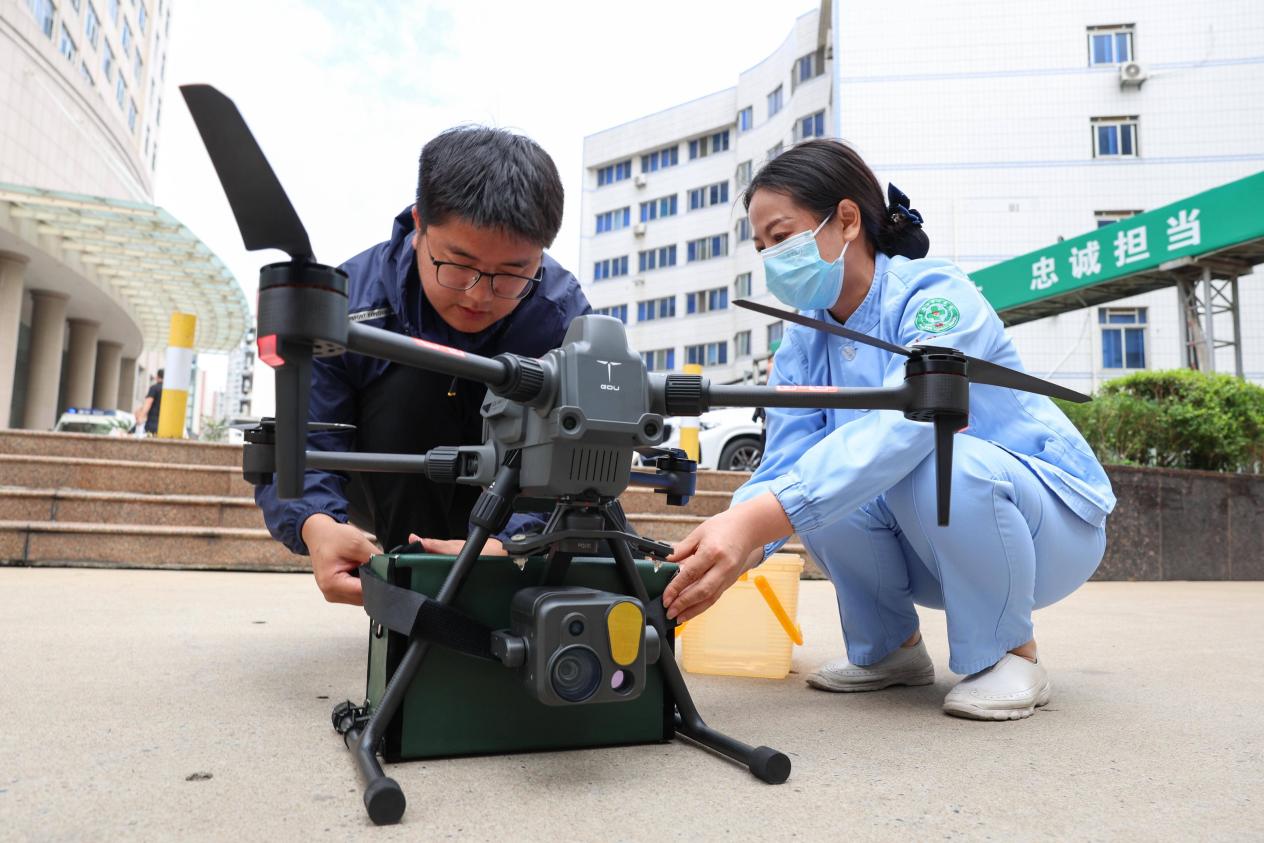




- BRNN
- BRI News
- BRNN News
- Database
Official Documents Polices and Regulations
Inter-government Documents International Cooperation BRI Countries
Business Guide Economic Data BRI Data
Trade
Investment Projects Latest projects
Cases - Content Pool

A fully loaded drone lands near an office building in Jinhua, east China's Zhejiang province. (Photo/Fu Jun)
In recent years, low-altitude logistics has been applied more and more widely across China.
During the busy lunch hour at a Shanghai business park, delivery drones hovered over designated pickup points. "I ordered milk tea from more than four kilometers away, and it arrived in less than 10 minutes. It's incredibly convenient," said a woman surnamed Wang who works in the park.
To enhance efficiency in specific zones, Shanghai has partnered with the technology-driven retail company Meituan to build a low-altitude logistics model featuring instant response and precision airdrop. Three drone routes now cover nearby universities and industrial parks, enabling deliveries in about 15 minutes.
In Suzhou Industrial Park, east China's Jiangsu province, a maiden flight was recently completed along a dedicated drone route for semiconductor testing samples. In less than an hour, samples were delivered directly to an enterprise's laboratory by drone, meeting the demanding time requirements of research and development process.
In Guiya village of Jiuwanxi township in Zigui, central China's Hubei province, drones efficiently transport navel oranges from mountain orchards. Moving 1,000 kilograms of oranges now takes just 10 minutes, a significant reduction from the previous three-hour journey.

A medical worker of a hospital in Xiangyang, central China's Hubei province loads blood samples onto a drone, June 3, 2025. (Photo/Yang Dong)
Connecting Shenzhen and Zhongshan in south China's Guangdong province, a commercial low-altitude logistics corridor establishes an aerial link. Once users place an order via a mini-program, small and urgent parcels can be delivered across cities in an average of three hours.
Over the past year, cross-city routes like Shenzhen-Zhongshan, Shenzhen-Zhuhai, Shenzhen-Dongguan have continued to emerge, weaving a fast-growing low-altitude logistics network across the Guangdong-Hong Kong-Macao Greater Bay Area (GBA). At present, Phoenix-Wings, a cargo drone company owned by Chinese logistics giant SF Express, handles an average of over 1,000 flights per day in the Greater Bay Area, transporting more than 20,000 parcels.
China's low-altitude logistics sector is evolving rapidly, transitioning from isolated pilot routes into interconnected networks and moving beyond niche applications into everyday use. This technology is increasingly integrated into various aspects of work and life, serving purposes from parcel delivery and agricultural transport to medical supply distribution. In 2024 alone, China launched more than 140 new low-altitude logistics routes, with approximately 90 percent operating within city limits.

A drone carrying 30 kilograms of parcels flies toward a post service station on the Yangtze River in Zhangjiagang, east China's Jiangsu province. (Photo/Xing Bin)
According to Dong Zhiyi, chief expert on low-altitude economy at the Chinese Society of Aeronautics and Astronautics, China's low-altitude logistics industry is mainly concentrated in the GBA, the Yangtze River Delta, the Beijing-Tianjin-Hebei region and the Chengdu-Chongqing area, while other regions focus primarily on specific scenarios. The GBA and Yangtze River Delta are economically advanced and rich in application scenarios; the Beijing-Tianjin-Hebei region has strong innovation capacity and clear spillover effects; and the Chengdu-Chongqing area leverages strengths in manufacturing and airspace resources to promote synergy and resource sharing.
"The growth of e-commerce and instant logistics has fueled consumer demand for faster and more personalized services, driving the release of market potential for low-altitude logistics," said Yan Yan, head of public affairs of drone service of Meituan. Drone delivery significantly reduces the impact of road traffic on delivery times. For items such as pan-fried buns or hot coffee that require high timeliness, drones can double delivery efficiency compared with traditional ground transport, Yan added.
Beyond speed, drones offer compelling cost advantages compared to conventional logistics. For instance, ZTO, a leading express delivery company in China, developed an electric hexacopter drone with a full lifecycle cost of 85,800 yuan ($12,071) and a capacity to deliver 75,000 parcels. The drone's per-parcel cost is 1.14 yuan. Based on the industry's average single-parcel cost of 1.85 yuan, this represents a reduction of about 40 percent.
With large-scale operations and the rollout of dedicated product services, logistics costs are expected to fall further, said Wang Qi, head of ZTO's drone project.
From Phoenix-Wings drones capable of handling diverse terrain to JD Logistics' multi-rotor smart drones, new technologies and products are steadily enhancing the reliability and efficiency of low-altitude logistics, revealing vast potential for industrial development.
Chen Xiaohui, director of public affairs at Phoenix-Wings, said that by leveraging drones' efficiency and flexibility, low-altitude logistics can solve delivery challenges that traditional transport struggles with, not only ensuring successful delivery but also helping enterprises shift from price-driven competition to value-driven competition.
"With the coordination between drones and ground vehicles, we can build a smart delivery network covering both urban and rural areas, further addressing the 'last mile' challenge," said an official from the State Post Bureau.
According to the China low-altitude logistics development report for 2024, the low-altitude logistics market is experiencing rapid growth. The market is expected to reach 120 to 150 billion yuan this year and climb to 450 to 605 billion yuan by 2035.

Tel:86-10-65363107, 86-10-65368220, 86-10-65363106